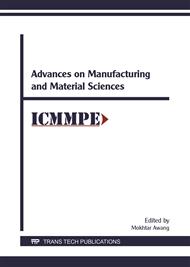[1]
Ahmad, J.K., 2015. Carburizing of Steel. International Journal of Materials Science and Applications, 4 (2-1), pp.11-14.
Google Scholar
[2]
R. Gorockiewicz & Lapinski, A., 2010. Structure of the carbon layer deposited on the steel surface after low pressure carburizing. Vacuum (Elsevier), 85, pp.429-33.
DOI: 10.1016/j.vacuum.2010.08.005
Google Scholar
[3]
Dragomir, D., Cojocaru, M.O. & Dumitru, N., 2013. The Effect of Change of Carburizing Media Nature on Growth Kinetics of Layer. U.P.B. Sci Bull, Series B, Vol. 75, pp.181-92.
Google Scholar
[4]
Chen, Y.C., 1992. Effect of H2O content in air on the carburizing behavior of charcoal gas. Journal of Materials Engineering and Performance, pp.383-391.
DOI: 10.1007/bf02652393
Google Scholar
[5]
Jimenez, H., Staia, M.H. & Puchi, E.S., 1999. Mathematical modeling of a carburizing process of a SAE 8620H steel. Surface and Coatings Technology, 120(121), pp.358-65.
DOI: 10.1016/s0257-8972(99)00464-8
Google Scholar
[6]
Younes, B. & Samira, M., 2015. Towards carburizing treatment applied on low alloy steel 16CN6. In 2015, I., ed. 2nd Conférence Internationale des Energies Renouvelables CIER-2014. Algérie, 2015. Proceedings of Engineering and Technology.
Google Scholar
[7]
Lou, D.C., Solberg, J.K. & T. Børvik, 2009. Surface Strengthening Using A Self-Protective Diffusion Paste And Its Application For Ballistic Protection Of Steel Plates.
DOI: 10.1016/j.matdes.2009.03.003
Google Scholar
[8]
Yoon, J.H., Jee, Y.K. & Lee, S.Y., 1999. Plasma paste boronizing treatment of the stainless steel AISI 304. Surface and Coatings Technology, 112, pp.71-75.
DOI: 10.1016/s0257-8972(98)00743-9
Google Scholar
[9]
Khosravi, H., Hosseini, S.R.E., Sisan, M.M. & Paykani, M.A., 2014. Modeling of Pack-Carburizing Route by General Factorial Design of Experiment. International Journal of Engineering Research & Technology (IJERT), 3(9), pp.948-51.
Google Scholar
[10]
Aramide, F.O., Ibitoye, S.A., Oladele, I.O. & Borode, J.O., 2009. Effects of Carburization Time and Temperature on Mechanical Properties of Carburized Mild Steel, Using Activated Carbon as Carburizer. Material Research, 12(4), pp.483-87.
DOI: 10.1590/s1516-14392009000400018
Google Scholar
[11]
MH Jumadin, B Abdullah, MH Ismail, SK Alias, S Ahmad, 2015. Investigation On Temperature Effect Of Carburized Steel Using Powder And Paste Compound. Jurnal Teknologi 76 (3) pp.57-61.
DOI: 10.11113/jt.v76.5512
Google Scholar
[12]
Alias, S.K. et al., 2013. The Effect of Carburizing Medium on Carbon Dispersion Layer of ASTM A516 steel. Vol. 393.
DOI: 10.4028/www.scientific.net/amm.393.212
Google Scholar
[13]
Muhammad Hafizuddin Jumadin, Bulan Abdullah, Muhammad Hussain Ismail, and Siti Khadijah Alias. 2016. Water-Based Pack Carburizing Technique: A Heat Treatment Practice for Sustainable Environment. Engineering and Technical Development for Sustainable Environment. Apple Academic Press, (2016).
DOI: 10.1201/9781315207322-10
Google Scholar
[14]
Alias, S.K. et al., 2013. Mechanical properties of paste carburized ASTM A516 steel. Procedia Engineering, 1(68), pp.525-30.
DOI: 10.1016/j.proeng.2013.12.216
Google Scholar
[15]
Elzanaty, H., 2014. Effect of Carburization on the Mechanical Properties of the Mild Steel. Innovative Space of Scientific Research Journals, 6(4), pp. pp.987-994.
Google Scholar


